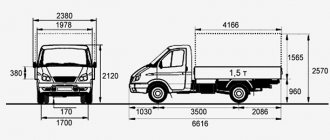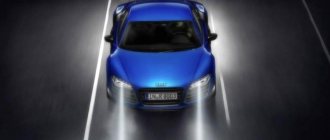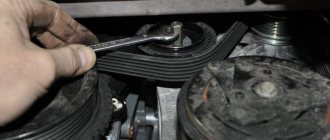Korean cars have firmly established themselves in the domestic market. However, the Russian car manufacturer is trying its best to compete and releases one successful model after another. The Lada X-Ray is considered one of the highest quality cars from AvtoVAZ.
The crossover has a good package and has a decent price. The key competitor of the Russian car is Kia Rio. This article will help you decide which car: Kia Rio or Lada X Ray should be chosen for comfortable driving on Russian roads.
Popularity and dimensions of vehicles
Korean cars from the Kia concern have been conquering the market for a long time. Like the Hyundai Solaris, the Kia Rio is one of the top sellers.
Nevertheless, the prestige of the Korean manufacturer is still at a fairly low level, not reaching such famous concerns as Volkswagen, Honda and Mercedes.
AvtoVAZ, on the contrary, has just entered the fight against foreign cars and is still far behind them. Domestic cars are seriously guilty of minor flaws and ill-conceived designs of running gear.
When choosing which is better: Lada X-Ray or Kia Rio, you should take into account the dimensions of the vehicles.
A car from a Korean manufacturer in a hatchback body has the following dimensions:
- length – 4,120 millimeters;
- width – 1,700 millimeters;
- height – 1,470 millimeters;
- weight – 1,120 kilograms.
The wheelbase of the Kia Rio is 2,570 millimeters, and the ground clearance is 160 millimeters. The luggage compartment volume with the seats up in the hatchback is 389 liters.
The domestic car can boast of the following weight and size parameters:
- length – 4,165 millimeters;
- width – 1,764 millimeters;
- height – 1,570 millimeters;
- weight – 1,190 kilograms.
The wheelbase of the Lada X-Ray is 2,592 millimeters, and the ground clearance is 195 millimeters. The trunk volume in the domestic crossover with the rear seats up is 361 liters.
According to the above data, we can conclude that the domestic car is significantly larger in size and has a significantly higher ground clearance. At the same time, the Korean vehicle is much smaller, but has a more capacious luggage compartment.
In general, it is difficult to determine which is better, since some people value compactness, while others want to drive a large car.
More expensive, two pedals
In the last table there are configurations with automatic transmissions or “robots” and quite good in content: for some it is full luxury (“French”), for others it is close to it (X-Ray), and for others it is “middle "("Koreans"). Prices are about 700,000 rubles. X-Ray turns out to be cheaper than the others and is a worthy competitor to the “Koreans” in terms of engine - here it again has a top-end 122-horsepower engine paired with an AMT “robot”. However, in terms of transmission, Solaris and Rio are more attractive - they have efficient 6-speed automatic transmissions. But the Lada Xray is again ahead of everyone in terms of safety, and for the money it’s the only one equipped with parking sensors and standard navigation.
Renault Sandero has only one unbeatable trump card - cruise control. And its “brother” and at the same time “brother” of the VAZ X-Ray on the platform, Sandero Stepway, in this company looks, if not poor, then a weak relative: its equipment is not bad, but probably not so much that for 715,000 rubles, you got a car with a “robot” and 82 “horses” under the hood. Can this be compared, for example, with the Solaris power unit? Or X-Ray? Or maybe put an “automatic” on this Stepway in the Privilege configuration? It’s easy, and the engine will still be 102 hp, but with such a power unit the car will fly away at a price of 750,000 rubles.
Power plants
When comparing the Kia Rio and Lada X-Ray, it’s worth saying a few words about the engines.
The Kia car comes with the following power plants:
- 4 liter petrol engine with 107 horsepower.
- 6 liter engine with 123 horsepower.
The first installation option is installed on budget versions of Korean cars. The 107-horsepower engine accelerates the vehicle to 100 kilometers in 11.6 seconds. The maximum speed is 185 kilometers per hour.
Special mention should be made of the very low fuel consumption, which when driving around the city does not exceed 8 liters per hundred kilometers.
The older model of the Rio car's power plant, complete with a 123-horsepower engine, is equal to 190 kilometers per hour. The increase in engine displacement had a slight effect on fuel consumption.
When driving around the city, the power plant empties the fuel tank by 8.5 liters per 100 kilometers traveled.
Domestic engineers equipped the Lada X-Ray with the following units:
- 6 liter petrol engine with 106 horsepower.
- 8 liter petrol engine with 122 horsepower.
The basic version of the power plant allows you to accelerate to 100 km/h in 11.4 seconds. The peak speed of a car with this engine is 174 kilometers per hour. Fuel consumption in city traffic reaches nine liters per 100 kilometers.
The older modification of the power unit accelerates the car to one hundred kilometers per hour in 10.4 seconds. The maximum speed is 185 kilometers per hour. Consumption has practically not increased compared to the base engine and is 9.4 liters per hundred kilometers.
From the comparison it is obvious that, despite the larger volume, AvtoVAZ engines could not compete with their Korean counterparts. The Kia Rio has similar dynamics to the Lada X-Ray, but at the same time consumes significantly less fuel and develops a higher maximum speed.
Comparison of technical characteristics
Almost every modern car enthusiast, when searching for a suitable car, first of all looks at its technical characteristics. That is why, first of all, it is worth considering the main and most important indicators and figures of the models:
- public sector employees have a Euro-5 environmental safety class;
- cars are sold only in front-wheel drive versions;
- the Korean and Czech models can only be purchased with a gasoline engine;
- The Rapid has a liftback body, while its competitor is released as a sedan;
- Rio's maximum speed is 185 km/h, Rapid's is 184 km/h;
- acceleration from zero to hundreds in Skoda occurs in 11.4 s, in Kia in 12.2 s;
- Rapid consumes 6.4 liters in the combined cycle. fuel, Rio 5.7 l;
- the Korean can be filled with AI-92 gasoline, its competitor with AI-95 fuel.
These are the main technical indicators of cars equipped with the weakest engines and manual transmissions, which have the lowest cost, which is why they are in greatest demand.
Gearboxes
The gearboxes used in vehicles will help you compare Lada x ray and Kia Rio.
The domestic vehicle has:
- Five-speed manual transmission. This type of gearbox is installed on both engine modifications.
- Five-speed robotic manual transmission. The decision to use a robot instead of an automatic machine is explained by the pursuit of making the car as cheap as possible.
The Kia car can be equipped with the following transmissions:
- Five-speed manual gearbox. This transmission option is used only for the younger 107-horsepower modification of the power unit.
- Four-speed automatic transmission. The junior automatic can only control a 1.4 liter engine.
- Six-speed manual transmission. The box comes only with a 123-horsepower engine.
- Six-speed automatic transmission. A modern automatic transmission is paired with an older version of the power plant.
It is thanks to the presence of a six-speed automatic that the Kia car confidently wins in the comparison of transmissions.
Summary
The 2020 Lada X-Ray Cross is only suitable for you if you need a car with a manual transmission. XRay will definitely please the future owner with the price of both the car itself and its maintenance and insurance. And, of course, the ground clearance of 215 mm will allow you to navigate rough terrain with peace of mind. The Kia Rio X-Line 2020, in turn, attracts with a wide technical variety of power units, fuel efficiency, a spacious trunk and the presence of options that, in principle, the competitor does not have. And if you need a car with an automatic transmission, then your choice is obvious!
Car suspension
Structurally, car suspensions are no different. In both cars, the rear suspension is represented by a semi-independent torsion beam, and the front suspension is represented by MacPherson struts.
When driving a Rio car on a flat road, the suspension works well against minor defects in the asphalt surface. When driving into rough terrain, all shocks begin to be transmitted to the steering wheel and make it difficult to control the vehicle.
In other words, driving the Kia Rio on rough terrain is problematic due to insufficient energy consumption and smoothness.
The behavior of a domestic car is completely different. Thanks to the well-designed suspension, the Lada X-Ray calmly passes through areas of any complexity and practically does not feel minor irregularities. However, due to the significant ground clearance, the Lada exhibits roll when cornering.
The cross-country ability of the X-Ray car is beyond praise. Thanks to the high ground clearance, the car can easily climb small obstacles, and the ESC system allows you to drive to heights unprecedented for Kia.
In terms of suspension, in a comparison of Kia and Lada X Ray, the domestic car wins a landslide victory.
About “recommended prices” and delivery times
It is worth noting a few more points that we identified while studying the configurations. The Kia and Hyundai websites list the "suggested" price, although after calling several dealers we realized their prices were the same. Both the Koreans and Renault had an additional incentive to buy until the end of January - a discount on cars produced in 2015; There are two price lists on the Renault website, for 2020 and 2016. But since February, prices have become equal - cars from both years of production cost the same money, and these are definitely not last year’s prices. For all foreign brands presented in the article, the wait for cars produced in 2016 ranges from a month to two. And for cheap versions without air conditioning, dealers generally call April-May as the order fulfillment period.
Options and prices
The Lada X-ray car is sold in three trim levels:
- Optima. The cost of this configuration on the Russian market starts from 600,00 rubles.
- Luxury A car version with a luxury set of devices will cost at least 710,000 rubles.
- Exclusive. The maximum version of the Lada XRay car will empty your wallet in the amount of 806,000 rubles.
The Korean car has six trim levels:
- Comfort. The cost of such a car starts from 640,000 rubles.
- Audio comfort. An additional purchase of a radio will cost 40 thousand.
- Luxury The cost for this version of the car starts from 710,000 rubles.
- Prestige. This version will cost the buyer at least 776,000 rubles.
- Premium The maximum configuration costs from 876,000.
- Premium NaVi. This version of the car costs from 903,000 rubles.
Engine and transmission
| Volume (hp), gearbox | KIA Rio X-Line | Lada Vesta SW Cross | Lada Xray |
| 1.4 (100), 6 manual transmission | X | ||
| 1.4 (100), 6 automatic transmission | X | ||
| 1.6 (123), 6 manual transmission | X | ||
| 1.6 (123), 6automatic | X | ||
| 1.6 (106), 5 manual transmission | X | X | |
| 1.8 (122), 5 manual transmission | X | X | |
| 1.8 (122), 5AMT | X | X |
KIA Rio X-Line can offer customers an automatic transmission. For now, only a “robot” is installed on LADA; an automatic transmission or a variator may appear in the near future.
Likely competitors of Kia Soul 3 (Kia Soul 3 2020 2020)
Haval is known for its long-term brand development strategy. The Chinese manufacturer intends to take first place in the world in SUV sales by 2026. The Russian market is among our priorities. This year, Haval localized the production of the F7 and F7x crossovers, as well as the H9 frame all-terrain vehicle at a plant in the Tula region.
The best-selling Haval model in Russia over the past three years has been the H6 all-terrain vehicle. Thus, before the appearance of the F7 model, “sixes” accounted for up to 75% of the brand’s sales.
The cars are completely different in appearance, but the difference in price is only 18 thousand rubles
On the Automps test, the most equipped Haval H6 in the Elite version. A car with a 1.5-turbo engine, 143 horsepower, automatic transmission6 and front-wheel drive is estimated at 1.382 million. The rival of the Chinese crossover is a newcomer to the Russian market - the third generation Kia Soul SUV.
Dude and just a hard worker
The city crossover from KIA is 45 centimeters shorter than its Chinese competitor, but otherwise the characteristics are similar. Under the hood of the test Soul there is a 150-horsepower naturally aspirated engine. Front-wheel drive, declared ground clearance is the same 180 millimeters. The price of a Prestige with a two-liter engine reaches 1 million 400 thousand rubles.
We sit in the front
Kia Soul
The cabin is comfortable, the ergonomics are exemplary, the seating position is high, visibility is excellent, and the controls do not require getting used to. However, the perception of the model depends on the configuration. Basic versions have a monochrome screen audio system, while the test car has a seven-inch touchscreen display.
Top version, all finishing elements speak for themselves.
Top-end Souls are equipped with a 10.25-inch monitor with a touchscreen. The same goes for finishing materials. Soft plastic is the prerogative of rich trim levels, starting with Prestige for 1.36 million rubles.
The initial versions are content with practical rigid elements. But the front seats are comfortable, regardless of the version. Even the basic fabric seats pleased me with sufficient lateral support and a good profile.
Haval H6
Driving a Hawala you don’t feel like you’re in a Chinese car. There are no obvious mistakes in ergonomics, and the build quality is at the level of its rival. The multimedia system and climate control unit are configured successfully. The panel is rigid, but the designer's work is visible.
A rigid panel, but attractive in appearance.
Although the demo H6 is in the maximum configuration, its finishing materials are more budget-friendly than those in the KIA. The plastic is hard, and the leatherette seats do not allow air to pass through. There are also complaints about the fit. Despite a wide range of electronic adjustments for the front seats, including adjusting the lumbar support, it was not possible to find a comfortable position.
The advantage of the Naval N6 is the amount of free space and equipment. Flat floor, automatic selector located on the front panel. The “extra” five centimeters of body width give a feeling of space. In the opening discipline it is equal.
Score 1:1
We test electronic systems - rollers.
KIA Soul - Haval H6 - front-wheel drive, there are no off-road modes, but the assistants are configured differently. KIA assistants are more tolerant of slippage.
However, Haval systems actively prevent slipping. The rivals had no problems with the rollers: both crossovers overcame the test when one wheel slips.
Score 2:2
Kia Soul - Haval H6 - Passing obstacles
It seems that at the bottom point of the “Soul” there is a little more than the passport 180 millimeters.
The declared ground clearance of both duelists is 180 millimeters. For the Russian market, Soul's ground clearance in the third generation increased by 27 millimeters. Let's see if this helps with the 200mm tire. The Korean all-terrain vehicle caught the tire on both the front and rear axles, but did not move the projectile.
The test Haval H6 has non-factory engine protection installed. The steel screen is mounted in the same place where the plastic boot should be. The attachment points coincide, so the accessory should not affect the experiment. The Haval H6 rested its front subframe against the tire - the ground clearance approximately corresponds to the declared value. The point goes to Kia.
Score 3:2
Rolling start – KIA Soul – Haval N6
The Chinese one and a half liter turbo engine with direct injection is more modern than the Soul power unit. It features higher productivity with a smaller working volume. Peak torque of 210 Nm is available from 2200 rpm, maximum 143 power - from 5600. In addition, the Chinese engine can run on AI-92 gasoline.
For naturally aspirated 2.0 KIA, 95 gasoline is recommended. The engine produces 150 hp. at 6200 rpm and 190 Nm of torque from 4000 rpm.
In terms of dimensions, the Haval H6 is comparable to the larger KIA Sportage. The mass of the Chinese all-terrain vehicle is 200 kilograms more than that of the Soul. Starting from 60 km/h, the crossover from the Middle Kingdom wins. The Haval H6 responds better to acceleration, but as it picks up speed, the KIA begins to catch up with its opponent. Adjusted for the driver's weight, all-terrain vehicles accelerate the same - equally.
Score 4:3
Let's look under the car
From an assembly point of view, there are no complaints about Soul. Looking under the crossover from below, we found neat insulation of weld seams and a high-quality noise-absorbing bottom coating. The engine is covered with a practical plastic protection with holes for changing the oil and filter.
Almost the entire bottom of the Soul is covered with plastic protection, also known as sound insulation.
The Korean all-terrain vehicle is made according to proven patterns: McPherson-type spring suspension in front, torsion beam in the rear, naturally aspirated engine is simple and unpretentious in maintenance.
Structurally, the Haval H6 is much more original. The Chinese crossover has both non-standard solutions and components designed with military reserves. For example, there is a massive steel subframe at the front, steel front suspension arms, and a metal engine sump.
A powerful subframe, bolted balls, everything speaks of the expectation of long and tough operation.
The Haval H6 can be ordered with a manual transmission and all-wheel drive. This is evidenced by the free central tunnel. The rear suspension is independent, double wishbone, mounted on a subframe. In the engine compartment, only the power steering is surprising - otherwise the engineering of the Haval H6 is modern. For inspection from below, both competitors receive a point.
Score 5:4
Luggage racks
Soul
The stated trunk volume with five passengers is 364 liters. In the initial state, the luggage compartment floor is installed flush with the doorway. But for greater capacity it can be installed lower, directly on the dock. According to the methodology of the magazine “Behind the Wheel”, the KIA fit 276 liters of cubes. See the video for all the download details.
Please note that the floor has two levels, the spare tire lives on the -2nd floor, and on the -1st floor you can store things that are rarely used. If necessary, the trunk is combined with the underground, increasing the volume.
Haval
The H6 is 454 millimeters longer than its rival, so the trunk capacity of the Chinese car is larger. The declared volume is 808 liters, however, manufacturers from the Middle Kingdom consider the free space to be loaded “under the roof”. Under the floor there is a full-size spare wheel on an alloy wheel.
Full spare wheel and large trunk. The choice is obvious.
According to the methodology of the magazine “Behind the Wheel”, the H6 fit 426 liters: a clear victory for the Chinese car in this discipline. For the Kia Soul, the trunk is clearly not a strong point.
Score 5:5
We're sitting in the back
The second row of the Haval H6 is very spacious: the Chinese SUV is wider and offers more legroom. There is an armrest with a cup holder, but the seat folds only in a 1:2 ratio, and there is no hatch for skis. The main complaint about the H6 is the lack of headroom.
The Soul has smaller doorways, tighter legs, but more headroom. There is no armrest or ski hatch, and there is no heating in the not-so-cheap Prestige package either. The point goes to the Chinese.
Score 5:6
KIA Soul - Haval N6 - Results
Although our test involved front-wheel drive crossovers on road tires, the duelists managed to drive surprisingly far along a rain-washed clearing. The “off-road” did not affect the final score.
Watch the report on mud swimming in the video - link below - the capabilities of front-wheel drive rivals surprised us. Both resisted until we stopped the battle so as not to spend the night in the forest.
The Kia Soul has proven itself to be a charismatic urban crossover with a decent interior. A variety of trim levels, a variety of power units and combined color options added to the charm. Soul will have no problems on the secondary market, and the proven filling has proven itself well.
Soul is a city slicker. Hawal H6 - larger in size for the same money.
Haval H6 beat Soul in a comparison test. The Chinese offers a more competitive price, a roomy trunk, a spacious interior and is slightly better off-road. The head-to-head comparison did not reveal any obvious shortcomings of the Chinese crossover. On the other hand, Haval still remains a “dark horse” with unknown reliability and liquidity.
Manufacturers' pricing policy:
A basic Kia Soul assembled in Kaliningrad is estimated at 1 million 30 thousand rubles. For this money they offer to purchase an all-terrain vehicle with a naturally aspirated 123-horsepower 1.6 engine and a 6-speed manual transmission. Versions with an automatic transmission start at 1 million 90 thousand rubles. For a modification with a 2.0-liter 150-horsepower engine you will have to pay at least 1 million 260 thousand. The top-end Soul GT Line with 1.6 T-GDI, 200 horsepower and a 7-speed “robot” is estimated at 1.63 million.
Prices for the front-wheel drive Haval H6 with a 6-speed manual transmission start at 1 million 128 thousand rubles. All-wheel drive versions start at 1 million 169 thousand rubles, but the basic equipment of such cars is simpler. Automatic versions are available only with front-wheel drive. Such H6s cost from 1.271 million to 1.322 million rubles. When purchasing cars of both brands, you can save money by agreeing to special offers or getting a discount from the dealer.
automps.ru
Cost comparison of Lada XRay and KIA Sorento
How much more expensive will an X-Ray with all-wheel drive become?
All the same, for now the serial LADA XRay and KIA Sorento are different types of cars. To make an accurate comparison, it is necessary to take cars with comparable characteristics, and this will not happen until the fall of this year, when X-Ray receives the Cross prefix. Only then will it be possible to determine all the pros and cons of these models.
As for the price of the KIA Sorento, in the “Business” configuration it costs from 977 thousand to 1 million rubles, depending on the transmission. The prestige version reaches 1.15 million rubles.
As for X-Ray, the most expensive package, including all the offered options, costs the buyer 723 thousand. The future will show how economic indicators will change.
More about Lada "X-Ray"
LADA XRAY vs Lifan X50: healthy competition
Comparison of performance characteristics of Lada Vesta and Lada XRay
A table of prices and configurations for Lada XRAY has been published
Lada Largus and Lada X Rey: is it worth comparing and by what parameters
Crash test Lada X Ray - 3 stars NCAP
Options
- The Kia Rio comes standard with a good audio system, electric windows on the front windows, heated mirrors and two airbags. The maximum configuration of the Korean has climate control, a more powerful music system, power windows on all windows, keyless access, a heated steering wheel, and additional airbags. For the Kia Rio, the maximum configuration is available with larger wheels - 16 instead of 15.
- The Lada Vesta's equipment in key points is similar to the Kia Rio. More expensive versions of the car are also sold with 16 wheels, and the basic version has 15 inches. The starting version is immediately equipped with ABS and exchange rate stability system.
Interior quality
Externally, the interiors of the Lada Vesta and Kia Rio are very similar to each other. The steering wheel, instrument panels, and multimedia system have more similarities than differences. Therefore, an inexperienced amateur is unlikely to be able to highlight the superiority of one of the models in relation to the other in this aspect of comparison. Let's try a closer analysis:
- Landing. Both cars can easily accommodate a six-foot person in the driver's seat. Lada Vesta has more space inside than Kia Rio. Both cars have comfortable and practical seats. For rear seat passengers, the Lada Vesta has more space, but the ceiling is lower.
Lada Vesta
Kia Rio
- Multimedia. Lada Vesta and Rio have similar systems, with high-quality displays. However, the Lada Vesta radio sounds better. The Russian car does not have a USB input, but is equipped with a slot for an SD card; the Korean car has the opposite.
- Luggage racks. Rio has a trunk volume of 500 liters, and Lada Vesta is 20 liters less. Also, the Kia Rio, unlike the Lada Vesta, has an additional button for opening the trunk under the license plate.
Lada Vesta Sedan
The Kia Rio
Lada Vesta has a drawback: when the engine is turned off, the heating continues to work, you have to turn it off yourself. By the way, the headlights are turned off in the same way. In addition, the Russian car, compared to the Korean one, does not have very impressive heating mode switches; outwardly, they look very fragile and dangle.











